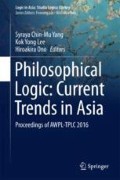Abstract
This paper is a sequel to Lee (2007) and Lee (2009). In Lee (2009) it is proved that there are weak subclassical predicate logics (which are classically sound but weaker than the first-order logic) which also satisfy the Classical Model Existence property (CME for short): Every consistent set has a classical model. In this paper we improve the result in Lee (2007) by showing that some weak propositional logics (extensions of the implicational linear logic BCI) also satisfy CME in propositional case. For subclassical predicate logics two types of approaches (by prenex normal form construction or by Hintikka style construction) will be considered. By this we prove that CME for predicate logics also holds for some subclassical logics with weak propositional part.
Access this chapter
Tax calculation will be finalised at checkout
Purchases are for personal use only
Notes
- 1.
Actually here we use axiom schemes, but call them axioms for simplicity.
- 2.
Here we omit, in Paoli (2002), the adjunction rule “from \(\alpha \) and \(\beta \) infer \(\alpha \wedge \beta \)” and replace \(\vdash \) by \(\Rightarrow \). We preserve the symbol \(\vdash \) for the standard provability in Hilbert systems.
- 3.
Precisely speaking, the negation completeness here is \(\rightarrow \bot \) completeness, which may not be equivalent to \(\lnot \) completeness while \(\lnot \) is a primitive logic connective.
- 4.
That is, if \(\varphi \) is an axiom of \({\mathscr {Q}_1}{\mathscr {H}}_i\), then so is \(\forall {\overrightarrow{x}} \varphi \).
- 5.
Add one if there is none.
References
Lee, J. -L. (2007). Classical model existence theorem in propositional logics. In J. -Y. Béziau & A. Costa-Leite (Eds.), Perspectives on Universal Logic (pp. 179–97). Italy: Polimetrica, Monza.
Lee, J. -L. (2007a). Classical model existence and left resolution. Logic and Logical Philosophy, 16(4), 333–52.
Lee, J. -L. (2009) Classical model existence theorem in subclassical predicate logics. I. In D. Makinson, J. Malinowski, H. Wansing (eds.), Trends in Logic: Towards mathematical philosophy Trends in logic—Studia Logica Library, vol. 28, (pp. 187-99). Dordrecht: Springer.
Paoli, F. (2002). Substructural Logics: A Primer, Trends in logic—Studia Logica Library: Kluwer Academic Publishers.
Author information
Authors and Affiliations
Corresponding author
Editor information
Editors and Affiliations
Rights and permissions
Copyright information
© 2017 Springer Nature Singapore Pte Ltd.
About this paper
Cite this paper
Lee, JL. (2017). Classical Model Existence Theorem in Subclassical Predicate Logics. II. In: Yang, SM., Lee, K., Ono, H. (eds) Philosophical Logic: Current Trends in Asia. Logic in Asia: Studia Logica Library. Springer, Singapore. https://doi.org/10.1007/978-981-10-6355-8_10
Download citation
DOI: https://doi.org/10.1007/978-981-10-6355-8_10
Published:
Publisher Name: Springer, Singapore
Print ISBN: 978-981-10-6354-1
Online ISBN: 978-981-10-6355-8
eBook Packages: Religion and PhilosophyPhilosophy and Religion (R0)

